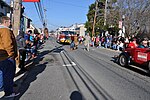Charlestown Historic District
Cecil County, Maryland geography stubsEastern Shore, Maryland Registered Historic Place stubsHistoric districts in Cecil County, MarylandHistoric districts on the National Register of Historic Places in MarylandNRHP infobox with nocat ... and 2 more
National Register of Historic Places in Cecil County, MarylandUse mdy dates from August 2023
Charlestown Historic District is a national historic district at Charlestown, Cecil County, Maryland, United States. It consists of a 150-acre (0.61 km2) portion of the town containing all known existing 18th century features. There are 14 houses known to have been constructed during that century and its largest structures were the inns and hotels which served the popular Charlestown Fair in the colonial period.It was added to the National Register of Historic Places in 1975.
Excerpt from the Wikipedia article Charlestown Historic District (License: CC BY-SA 3.0, Authors).Charlestown Historic District
Market Street,
Geographical coordinates (GPS) Address Phone number Nearby Places Show on map
Geographical coordinates (GPS)
| Latitude | Longitude |
|---|---|
| N 39.573888888889 ° | E -75.975555555556 ° |
Address
Saint John's Methodist Church
Market Street 226
21914
Maryland, United States
Open on Google Maps








